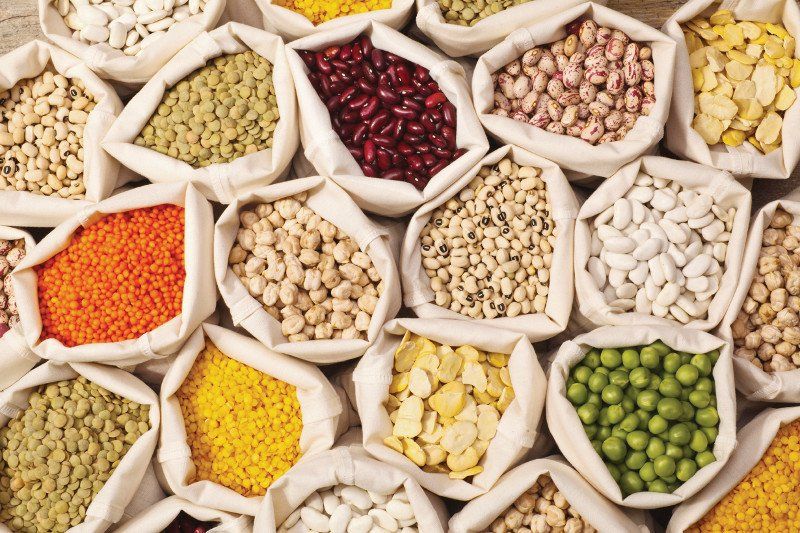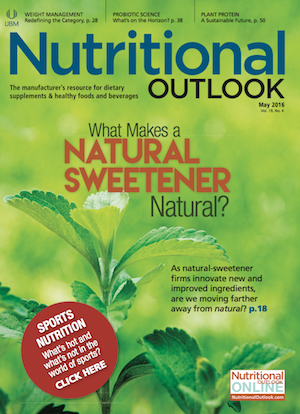The ABCs of Formulating with Plant Proteins
Key formulation priorities to consider when choosing your plant proteins
Photo © iStockphoto.com/syolacan

Competition breeds innovation, and nowhere in the ingredients industry is this more evident than with proteins. As the consumer base for protein foods and supplements continues to grow, protein-ingredient manufacturers and finished-product marketers are exploring every possible avenue to stay current and open to new trends on the market.
In particular, the booming popularity of plant proteins has formulators looking for the best way to combine different proteins to achieve the optimal nutrient profile, taste, and texture for a given application. Now that consumers are looking beyond traditional dairy, egg, and soy proteins to a growing roster of plant-based proteins, there’s an almost dizzying array of options to choose from. Within just the past few years, there has been a tremendous surge in the popularity and availability of plant protein sources on the market, such as pea, rice, sacha inchi, hydrolyzed wheat, hemp, coconut, sunflower, pumpkin, cranberry, quinoa, chickpea, potato, and algae, just to name a few.
Whether the product is a powder, gummy, clear beverage, bread, or yogurt, knowing how to select proteins with compatible characteristics is an essential step in any successful product development. How does a finished-product manufacturer begin to navigate the many options to determine the best ingredient for a consumer product?
Finding the Balance
One of the first things to keep in mind is that formulating a protein product requires a juggling act. Selecting the right protein or combination of proteins involves a compromise between the benefits and drawbacks of each ingredient’s flavor, smell, texture, visual appearance, and marketability-all while meeting a target price of goods. A plant protein can be a terrific option to satisfy many of these formulation challenges.
Keeping the target consumer in mind helps narrow down protein choices. For example, the bodybuilding and sport markets tend to favor animal-based proteins. These demographics were around long before the rise of plant proteins and have therefore been exposed to many years of marketing focused on animal proteins. The good news is these groups tend to appreciate new scientific research, including recent studies suggesting plant proteins can be just as effective as animal proteins for hardcore athletes. Results from a 2013 double-blind study1 at the University of Tampa indicated that rice protein and whey protein have identical benefits to muscle building and retention. Similarly, research conducted on pea protein2 supported its ability to improve muscle thickness when compared to whey protein.
From a price perspective, co-formulating with lower-priced plant proteins like pea and rice can counterbalance the higher cost of whey and other dairy proteins. Another angle to consider is that consumers committed to whole, “natural” foods tend to gravitate toward plant proteins primarily due to their cleaner and more environmentally sustainable image. Incorporating plant proteins into formulations allows the manufacturer to offer its consumer a perceivably “healthier” product.
Sprouted brown rice protein, for instance, hones in on two hot-button marketing trends: sprouted grains and whole grains. Many plant proteins, such as pea and sacha inchi, are also offered as certified organic, non-GMO, and gluten and allergen free. Additionally, plant proteins like hemp and algae can offer an environmentally friendly image, and they are no longer considered fringe ingredients.
STORY CONTINUES ON PAGE 2
Flavor Rules
Ideally, the perfect protein ingredient would be flavorless, as this would allow the most versatility in custom flavor applications. However, real foods, from which natural proteins are derived, have distinct flavors. Even whey, arguably the king of proteins, still tastes like dairy. Soy protein has plant-like, beany notes, as one would expect from a legume. However, over the years formulators have learned to work with these flavor challenges and have developed some marvelous innovations.
In many circumstances, proteins make up a larger percentage of a finished product compared to other functional ingredients, so their characteristics can have a major impact on the final flavor and texture. For example, pea protein has a thick mouthfeel, and it can impart nutty, earthy, and savory flavors. Rice protein has a milder, cereal-like taste, but it can be slightly gritty and render a poor mouthfeel. Hemp, sacha inchi, sunflower, and pumpkin seed proteins all have varying degrees of seed-like nutty and green flavors.
Many of these proteins can also impart varying degrees of bitterness. These inherent flavor characteristics can either work to the advantage or disadvantage of the formulation, depending on the target flavor of the finished product. Unfortunately, more often than not these base protein flavors can be challenging when featured in a neutral flavor base, such as vanilla.
One way to overcome this is to find a congruent flavor that works with the flavor of the base protein. Earthy or beany notes work well with nut flavors such as peanut butter, with baked flavors like caramel pretzel, or with chocolate flavors. Astringency complements citrus flavors, as it enhances the flavor, while bitter notes can blend into chocolate or coffee flavors. Green notes can enhance jam-like berry flavors that lack greenness to create a balanced strawberry flavor.
Alternatively, bitterness can be muted by increasing the intensity of the sweetener system or modulating the perception of sweetness through suggestively sweet aromas. This works because the human brain is hardwired to taste sweet over bitter. A little salt can also aid in overcoming some bitterness, or more advanced technologies can actually block the tongue’s bitter receptors. Partnering early with a good flavor house that’s familiar with protein formulation can tremendously speed up the formulation process.
Flavor “fade” is one more protein-formulation challenge to stay aware of. Proteins are good at binding or absorbing flavor; the protein folds around another flavor in the formulation and hides it. In this scenario, adding more flavor can help compensate for any lost flavor, but flavor adjustments should be given some time to rebalance a few days before tasting. Protein flavor binding can also continue well into the product’s shelf life.
It Has to Feel Good
Texture can be as much of a formulation challenge as taste, but thankfully plant proteins offer a variety of available textures and mesh-size options. Typically, less gritty and smoother-texture plant-protein options are available, though they can be priced higher due to added processing.
Ideal protein texture often varies depending on the application. For instance, a high-protein, ready-to-mix powder formulation for the bodybuilder, sport, or whole-food consumer may compromise by prioritizing lower-cost options over smoothness to keep consumer price at a tolerable level. On the other hand, formulations targeting taste-conscious mass consumers interested in a smaller protein serving size might be able to absorb the higher cost of smoother-protein options.
Ready-to-drink beverage formulations pushing above 8 g/8 oz per liquid serving can also benefit from an extra-smooth protein due to the texture of the protein, which has a higher impact on a formulation at higher concentrations. Likewise, at low concentrations, a protein’s texture may not be as readily discernable. Certain types of bars and cookies might benefit from a coarser-mesh protein to achieve a certain mouthfeel.
Finished-product manufacturing conditions can also affect the final texture. Formulating around a protein’s isoelectric point, the pH level at which protein molecules have a zero net charge, can help proteins stay in solution. Otherwise, there may not be sufficient electrostatic repulsion between the protein molecules to keep them apart, causing them to aggregate and possibly introduce additional grittiness into the formulation. Salt can have a similar effect. Low concentrations of salt can help with solubility because salt ions interact with the protein molecules’ ionic charge and keep the proteins from interacting with each other and aggregating. However, overly concentrated salt ions can overpower a protein’s interaction with water and cause the proteins to interact with each other, often to the detriment of the formulation. Excessive heat can also denature the protein molecules, causing them to aggregate and fall out of solution.
Generally, a large majority of the available plant proteins are not entirely soluble in water. Using stabilizers such as hydrocolloid gums or modified starches can help suspend protein molecules and any other non-protein ingredients for a smoother mouthfeel.
STORY CONTINUES ON PAGE 3
Mix It Up, Play with It
There’s also an argument to be made for combining different proteins to minimize unwanted off-flavors and grittiness. Mixing whey protein with plant proteins can smoothen out texture from gritty plant proteins, while plant proteins can balance out the flavor of whey protein where the dairy flavor may be too strong.
Beyond the main protein sources, adding additional functional ingredients is an easy way to create product differentiation and enhance marketability. For instance, collagen, also a form of protein, can add an angle for strong bones and joints, supplementing the active-lifestyle image of protein.
Digestive health is extremely popular right now as well. Adding in a probiotic or, better yet, a prebiotic, can help build a healthy gut to effectively digest and benefit from all that added dietary protein. There are also highly bioavailable forms of both zinc and magnesium to consider because heavy exercise may deplete both of these minerals. Magnesium is a key electrolyte, and some magnesium forms have even been shown to help with cognition. Zinc affects protein synthesis and helps to maintain energy levels.
Juggling the right plant-based proteins to produce a successful formulation is certainly full of challenges, but with a flourishing market, the opportunities for finished-product manufacturers make the effort well worth it.
Alan Rillorta is the director of protein and branded ingredient sales at AIDP (City of Industry, CA). He is responsible for the development of innovative ingredients and collaborating with formulators to use these ingredients in successful new product launches.
Also read:
Plant Protein's Sustainability Benefits for the Planet and Your Business
Plant Protein: 2015 Ingredients to Watch for Food, Beverage, Supplements
Mankai Vegetable Protein Offers Water Savings, Year-Round Production, says Firm
Plant Protein: Searching for the Next Soy
Pea Protein Is Coming Up Strong
Plant Protein versus Dairy Protein for Muscle Building
References:
- Joy JM et al., “The effects of 8 weeks of whey or rice protein supplementation on body composition and exercise performance,” Nutrition Journal, vol. 12 (June 2013): 86
- Babault N et al., “Pea proteins oral supplementation promotes muscle thickness gains during resistance training: a double-blind, randomized, placebo-controlled clinical trial vs. whey protein,” Journal of the International Society of Sports Nutrition, vol. 12, no.1 (January 2015): 3

























